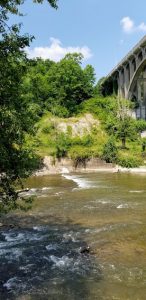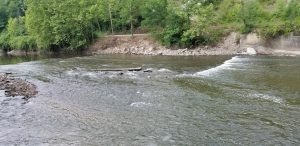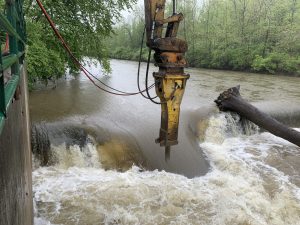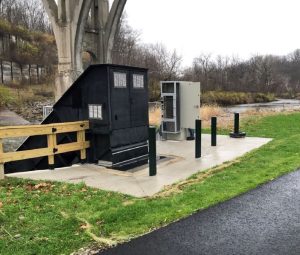Canal Diversion Dam Removal
 Purpose of the Project
Purpose of the Project
The purpose of the Canal Diversion Dam Removal Project was to allow restoration of both the riverine habitat and ecological health of the Cuyahoga River, upstream from the dam’s location at approximately River Mile 20.7. This is just upstream from the State Route 82 bridge that connects Sagamore Hills Township in northern Summit County to the City of Brecksville in Cuyahoga County. Completion of the project has removed a barrier on the river to Lake Erie fish migration and a safety hazard for paddlers. Qualitatively, this project also assisted in the removal of Beneficial Use Impairments (BUIs) within the Cuyahoga River Area of Concern that are associated with fish populations, benthos, and habitat. Due to delays caused by the pandemic, Ohio EPA has not yet performed a quantitative water quality assessment on this section of the Cuyahoga River to determine whether BUIs still exist. This project is listed as an implementation action in the US EPA-approved Lower Cuyahoga River Total Maximum Daily Load (for watersheds that do not meet the water quality goals of the Clean Water Act).
Who’s Involved
The managing partners involved with this project were the Friends of the Crooked River (FOCR), an environmental nonprofit organization and the project lead, US EPA Region 5 Great Lakes National Program Office (GLNPO), Ohio EPA, Ohio Lake Erie Commission, National Park Service (NPS)/Cuyahoga Valley National Park (CVNP), the Northeast Ohio Regional Sewer District (NEORSD), the City of Akron, and the Northeast Ohio Four County Regional Planning and Development Organization (NEFCO). The permitting agencies include the Ohio EPA, Ohio Department of Natural Resources (ODNR), State Historic Preservation Office (SHPO), US Army Corps of Engineers (US ACOE), and NPS. The property owners include the NPS/CVNP, ODNR, Ohio Department of Transportation, and Cleveland Metroparks.
Funders
 US EPA Region 5 GLNPO and the Ohio EPA funded the project. NEFCO received an $800,000 grant from US EPA in 2019 for the Canal Diversion Dam Removal Project through US EPA’s Great Lakes Restoration Initiative (GLRI). FOCR is the subrecipient of the NEFCO’s grant and is the implementor of the project. Other project moneys include Supplemental Environmental Project (SEP) funds from the City of Akron and NEORSD. In 2017, FOCR received access to $900,000 in SEP funds from Ohio EPA for the project. Those SEP funds are from the City of Akron’s federal court consent decree regarding its combined sewer overflows abatement implementation. SEP funds provided by the NEORSD will be for the long-term operation and maintenance of the needed river water pump station.
US EPA Region 5 GLNPO and the Ohio EPA funded the project. NEFCO received an $800,000 grant from US EPA in 2019 for the Canal Diversion Dam Removal Project through US EPA’s Great Lakes Restoration Initiative (GLRI). FOCR is the subrecipient of the NEFCO’s grant and is the implementor of the project. Other project moneys include Supplemental Environmental Project (SEP) funds from the City of Akron and NEORSD. In 2017, FOCR received access to $900,000 in SEP funds from Ohio EPA for the project. Those SEP funds are from the City of Akron’s federal court consent decree regarding its combined sewer overflows abatement implementation. SEP funds provided by the NEORSD will be for the long-term operation and maintenance of the needed river water pump station.
NEFCO’s Role
NEFCO managed the $800,000 US EPA grant. The funding from the GLNPO GLRI grant was essential for completing the project. NEFCO was responsible for tracking this funding and for providing this final report, and for providing past grant progress and financial reports to US EPA Region 5 GLNPO. Local funds from NEFCO’s dues paying members were provided to cover NEFCO’s administrative expenses when the US EPA grant funds had been exhausted.
Progress to Date
 Demolition of the Canal Diversion Dam by FOCR’s contractor began on May 21, 2020. The 1952 Canal Diversion Dam was constructed of concrete and steel reinforcement bar. The 1827 Pinery Dam was located a few yards upstream from the Canal Diversion Dam and was constructed of wooden timbers that were still intact when they were removed by the project’s contractor. Both dams were removed by early summer 2020. By mid-August 2020, clean-up and riverbank stabilization had been completed. The final phase of the project was the installation of an Archimedes screw pump by FOCR’s contractor. The screw pump is needed to provide river water once again to a historic section of the Ohio & Erie Canal in the Cuyahoga Valley National Park.
Demolition of the Canal Diversion Dam by FOCR’s contractor began on May 21, 2020. The 1952 Canal Diversion Dam was constructed of concrete and steel reinforcement bar. The 1827 Pinery Dam was located a few yards upstream from the Canal Diversion Dam and was constructed of wooden timbers that were still intact when they were removed by the project’s contractor. Both dams were removed by early summer 2020. By mid-August 2020, clean-up and riverbank stabilization had been completed. The final phase of the project was the installation of an Archimedes screw pump by FOCR’s contractor. The screw pump is needed to provide river water once again to a historic section of the Ohio & Erie Canal in the Cuyahoga Valley National Park.
By early summer 2021, FOCR’s contractor received the needed electric power to the screw pump installation site. After manufacturing and shipping delays caused by the COVID 19 pandemic, the screw pump was finally delivered and set in place by FOCR’s contractor on January 25, 2022. On May 12, 2022, FOCR’s contractor performed a successful start-up of the screw pump with key members of the project team present at the project site. On the evening of May 23, 2022, an unforeseen setback occurred when the screw pump’s discharge pipe outlet became clogged with debris, causing a back-up and overflow of river water from the pump station’s discharge box, which caused erosion and a cave-in of the soil that supported the pump’s electrical panel, which then leaned and came to rest against the undamaged, stable screw pump.
By May 27, 2022, FOCR’s contractor had righted the pump’s electrical panel, and had stabilized the soil surrounding it and the screw pump. However, another unforeseen setback occurred on August 18, 2022 when the electrical panel’s variable frequency drive (VFD) failed. The VFD allows the pump’s discharge rate to be adjusted to less than the maximum discharge rate of 20 cubic feet per second. The VFD is being replaced under warranty but isn’t expected to be delivered for installation any sooner than late March 2023. FOCR has SEP funds available to complete this work and its contractor is under contract to complete it.
 By March 28, 2022, all federal funds from this grant had been expended and NEFCO began using local funds to administer it. Therefore, with 100% of the environmental aspect of the project completed and with less than 5% of the historical aspect of it remaining, and with the support of all the key project partners, on November 30, 2022, NEFCO submitted a budget amendment to US EPA’s Region 5 GLNPO and requested that the agency close out the grant.
By March 28, 2022, all federal funds from this grant had been expended and NEFCO began using local funds to administer it. Therefore, with 100% of the environmental aspect of the project completed and with less than 5% of the historical aspect of it remaining, and with the support of all the key project partners, on November 30, 2022, NEFCO submitted a budget amendment to US EPA’s Region 5 GLNPO and requested that the agency close out the grant.
Final Report
The final report, for which US EPA approval was received on August 28, 2023, cumulatively documents the project’s progress and environmental progress under the project in six-month intervals over the entire project/budget period. It also incorporates photo documentation of the project and environmental progress under the project at appropriate phases. It is written in the same format, and contains much of the same information as the semi-annual progress reports that NEFCO submitted to US EPA Region 5 GLNPO over the course of the grant’s project/budget period.
Questions?
For further information or to answer questions regarding the Canal Diversion Dam Removal, please contact Tom LaPlante.
